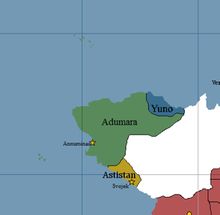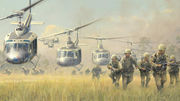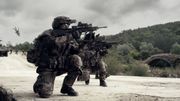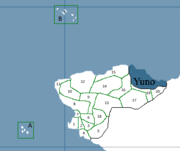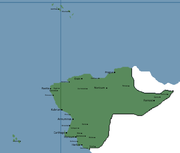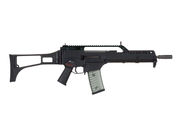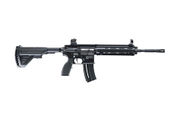Difference between revisions of "Adumara"
(→Economics) |
(→Economics) |
||
| Line 213: | Line 213: | ||
When it was founded, in 2010, the unemployment rate was at 18.6%. But after several years of success, the unemployment rate as of January 2017 was only 4.4%. | When it was founded, in 2010, the unemployment rate was at 18.6%. But after several years of success, the unemployment rate as of January 2017 was only 4.4%. | ||
| + | |||
| + | ===Trade with Foreign Entities=== | ||
| + | The Federal Republic engages in trade with many NGOs and Governments across Urth, including the following: | ||
| + | |||
| + | - [[Fortuna|The Second Fortunan Empire]] | ||
| + | |||
| + | - [[United Kingdom|The United Kingdom of Great Morstaybishlia and Justelvard]] | ||
| + | |||
| + | - [[Nation/Stratarin|The Militarized Communist State of Stratarin]] | ||
| + | |||
| + | - [[Tivot|The Republic of Tivot]] | ||
| + | |||
| + | - [[Tuvaltastan|The Democratic States of Tuvaltastan]] | ||
| + | |||
| + | - [[South Hills|South Hills Council of Governments]] | ||
| + | |||
| + | - [[Asendavia|The Empire of Asendavia]] | ||
| + | |||
| + | - [[Kuthernburg|United Kingdom Of Kuthernburg and Altaesia]] | ||
==Infrastructure== | ==Infrastructure== | ||
Revision as of 20:10, 12 December 2017
| Federal Republic of Adumara | ||||
|---|---|---|---|---|
|
||||
| Motto: "Wir beugen uns kein Knie" |
||||
National Map
|
||||
| Capital | Annuminas | |||
| Largest city | Carthago | |||
| Official languages | Adumaran(89%), Taikow or Marion(7%), Codexian(3%), Other(1%) | |||
| Ethnic groups (2016 Estimate) | Adumaran(89.3%), Staynish(3.7%), Marion or Taikow Islander(3%), Leese(2.4%), Other(1.6%) | |||
| Demonym | Adumaran | |||
| Government | Social Democratic Republic | |||
| - | Chancellor | Ardis Kane | ||
| - | Minister of Domestic Affairs | James Dhurgon | ||
| - | Grand General | Otto Dominik | ||
| - | Minister of Foreign Affairs | Audin Raphael | ||
| - | High Admiral | Hugo Vasiliev | ||
| Legislature | Federal Senate | |||
| Area | ||||
| - | Total | 1,172,970.37 km2 728,850 sq mi |
||
| Population | ||||
| - | 2016 estimate | 97,838,389 | ||
| - | Dec 2017 census | 101,708,692 | ||
| GDP (nominal) | Feb 2017 Est. estimate | |||
| - | Total | $1,944,067,009,000 | ||
| - | Per capita | $26,430.2 | ||
| Currency | Dal ц (ADL) |
|||
| Date format | MM/DD/YYYY | |||
| Drives on the | the right | |||
| Calling code | +66 | |||
| ISO 3166 code | ADU | |||
| Internet TLD | .ADU | |||
The Federal Republic of Adumara, commonly referred to as Adumara, is a nation on the continent of Concord. It borders the nations of Yuno, Astistan, Cynthia, and Tyalimar, and is directly west of South Hills(SHACOG). Because of its location, Adumara experiences relatively mild seasons. The Taikow and Marion island territories are very tropical in nature, and most land that is not urbanized is covered in dense jungles or sprawling, sandy beaches. The Marion islands are the ideal place for vacations to take place, and because of this, the Government generates tens of thousands in income from tourism on those islands. But the Taikow islands are a completely different story, having a long history of terrorism and piracy from those few who opposed the annexation of the islands by Adumara. Because of this, the southern islands chain is rarely visited by tourists and those not involved in the military or there for Government duties.
Contents
History
Ancient Era(7,000 BC - 341 BC)
The first records of a state date back to around 7,000 years BC(est.), where the Kingdom of Ardan reigned. Many years after, in 5,200 BC, another kingdom rose, and soon was followed by 3 others across what is now modern-day Adumara. Wars, Trade, Diplomacy, and other interactions occurred between these states for several millennium, with very little outside interaction.
Unification Period(342 BC - 559 AD)
Eventually, in 340 BC, the 5 Nation states unified into the First Confederation, which was a loose grouping of like-minded states. This allowed for rapid expansion and goals to be set outside the confines of the region for once, and Adumara quickly became a regional power, after expanding Eastward for a while. This eventually ended in the First Adumaran Civil War, in 560 AD, which was the bloodiest war known in Adumaran History, with an estimated casualty count of over 960,000 civilians and soldiers loosing their lives, and countless more being injured.
Kingdom of Adumar(560 AD - 1400 AD)
The Second Confederation was formed in 572 AD, this time with a single ruler to call "King", although he was mostly a puppet for the Lords of the Kingdoms. The Imperialist Age started in 800 AD, resulting in even further expansion Eastwards, and even a few minor over-seas colonies(the exact whereabouts lost to time). But this imperialist attitude also caused tensions to rise between the Lords, and selfishness to run rampant in the Confederation. This resulted in the Second Adumaran Civil War, in 1,100 AD, which was far less bloody and destructive than the last, but changed the minds of Adumarans forever.
Adumaran Empire(1401 AD - 1769 AD)
After the Second Civil War, the Lord of the Kingdom of Ardan, Lord Haldir, became tired of such disorder and chaos, and decided to take matters into his own hands. He began a campaign to take over the other kingdoms, and finally unify the 5 Kingdoms. 3 of them fell relatively quickly, as they were weakened by the Civil War, but the last continued to fight on for a long while, using guerrilla warfare, but finally conceded several decades later.
This new "Adumaran Empire" once again became a massive power, expanding overseas territories, and attempted colonization of Gondwana and Arcturia, which eventually failed. The Third, and final, Adumaran Civil War broke out in 1642, but didn't officially end until 1768, when the final kingdom was reconquered.
Imperial Decline(1770 AD - 1855 AD)
But, this war had weakened the Nation, and a line of several bad Kings resulted in the loss of overseas colonies, as well as the loss of huge chunks of land out East, forming most of what is modern Adumara. But the Islands and part of the Adumaran Desert remained independent.
Modern Era(1860 AD Onwards)
Years later, in 1860, the Confederation/Empire was finally reformed into the Republic it is today, and began to prosper once more.
Island Unification War
The Taikow(southern) and Marion(northern) island chains had long been independent, only the Marion islands being admitted to the Confederacy late in its life, and the Taikow islands not being forcefully admitted until much later.
The Island Unification War was a conflict that lasted between 1953 - 1960, between the FRA(Federal Republic of Adumara) and the TAC(Taikow Anarchist Coalition) over control of the Taikow Island Chain. It started when the Adumaran Government took an interest in the renewable energy industry, or what little there was of it. The Taikow and Marion Islands had been known to have massive dormant volcanoes scattered across them, which were a great source of Geothermal Energy. Since there was no government ruling over the islands that was recognized by anyone, the FRA decided to send a Battleship to scare the natives into surrender in 1952. Instead, when the landing party arrived, they were captured, skinned alive, and then cooked to death, all in front of their crew mates on the ship. The Battleship quickly steamed home to notify the FRA.
The following year, the FRA showed up with a massive task force, at least 18,000 strong, and landed on the largest of the Islands to use it as a staging ground. The Island was mostly open terrain, so it wasn't too terrible difficult to subdue. But the other islands in the chain were a completely different story. It took around 3 1/2 more years to fully conquer the islands, and another 3 1/2 years to kill the remnants and Guerrilla Fighters. Even to this day it is an extremely unstable territory, with citizens mainly staying to the towns and cities of Toron, while the other islands have massive geothermal plants on them with a strong paramilitary presence.
Konrak War(Operation Sandstorm)
The last District to be absorbed by the Republic, the Konrak Desert has historically been a politically and socially unstable region. While the Empire was in decline, the Arid region broke off in 1834 and became the Konrak Principality, ruled by a Grand Magister and a Prince. In 1862, when the Republic had stabilized, it attempted an invasion of the Principality, but failed quite miserably, underestimating the level of organization it had acheived.
The FRA tried once more to take back the desert region in 1993 in Operation Sandstorm. This war would last from 1993 - 2001.
The invasion began in the middle of the night, when around 430 Adumaran Army soldiers took the town of Dumar, with little resistance. Once fortifications were set up, and a makeshift airfield dug out, Sea Stallion Helicopters began airlifting men to Dumar, totaling up to 4,350 men. But near the end of the airlifting process, Konraki warriors attacked Dumar, but were successfully repelled 7 times due to the more advanced weaponry and better experience of the AAF forces. Eventually, when the airlifting ended, ground convoys had arrived with around 74 Main Battle Tanks, and 870 APCs, and the AAF advanced into the Principaility, fighting off the Konraki warriors harrassing Dumar.
Within the first 2 years, 14 other towns and cities had been reconquered, and bye early 1997, well over half the nation had been subdued. By this point, the Grand Magister was willing to surrender, and almost did before he was murdered by the Prince, who ran off deeper into the desert with military forces that were loyal to him, and founded the Konrak Independence Front(KIF). Many men and women respected the Magister's decision, and surrendered to the FRA, who's numbers in Konrak by this point were swelling to 7,800. Most of the nation was quickly conquered, with only a small area occupied by 3 towns remaining with the KIF. The KIF received weapons and supplies from a nation who had recognized them and were backing them, known as the Stellar Archipelago of Syllvania.
By this point, the FRA government was getting tired, and decided to have one final push, which worked remarkably well, and crushed the KIF opposition. The few remaining Rebels, estimated around 68, scattered throughout the Konrak desert, and occasionally skirmish with FRA police and military forces.
Astistani Invasion(Trioch War)
One of the few neighbors of Adumara, the state of Astistan was an unstable mess. It was very liberal, in the sense that citizens had almost unlimited freedom, but they were very nationalist and relatively militaristic. Because of these traits, the FRA government, in 2007, decided to invade the nation to "protect domestic interests", and to "maintain the security of Adumaran citizens". This would spark the relatively short Trioch War, which would last for 2 years(2007 - 2009), and was named for the town of Trioch that the war started in.
Moments after the FRA declared war on the smaller state, 1,600 AAF soldiers advanced on the town of Trioch, which, at the time, was on the border between the two nations, just inside Astistan. The Astistani Volunteer Army had been using relatively outdated technology at the time, and was primarily used for putting down small insurgencies. Therefore, it wasn't able to put up much of a fight against the Adumaran Battle Tanks and other armored vehicles. The AAF rolled into town, destroying the small military base in the town square with ease, and driving off the resistance forces. From then on, Trioch would remain under Adumaran control, being handed over in the peace treaty towards the end of the war.
Both sides remained quit for several months, until the AAF had ammassed around 8,300 soldiers and complimentary vehicles. They advanced onto the next city, Doksy, which put up an unexpectedly large amount of resistance, dragging the war on for another 9 months. This put it past its halfway point, and the AAF behind schedule. So, with the generals becoming impatient, they began bombing the town with Artillery and Airstrikes. At the same time, several Amphibious Assault Ships deposited around 4,120 AAF soldiers and equipment in the undefended city of Novak. They quickly took control of the city, causing the Astistani Army to redirect forces away from Doksy. This, combined with dwindling numbers in the city, is what led to the fall of Doksy, and most of the remaining forces loyal to Astistan. The AAF then marched through the countryside, capturing small towns and villages along the way, toward the capital of Svojek. The forces had to move slowly for fear of a guerilla attack by the remaining Astistani forces, but eventually made it to the weakly defended Svojak, which fell in a matter of weeks.
It took around 1 1/2 months for the remaining Astistani forces to surrender, concluding the war. Most of the land was ceded to a puppet government made by the FRA to rule Astistan, but full autonomy was granted only weeks later.
Politics
There are 2 primary branches of the Adumaran Government: - The Executive Branch: The Chancellor and his Advisory Cabinet. The Cabinet is made up of 5 officials chosen by the Chancellor, who are the following: Grand General, High Admiral, Minister of Trade, Minister of Domestic Affairs, and Minister of Foreign Affairs. These 5 men and women have the power to direct the affairs of each of their respective branches, under the oversight of the Chancellor. In times of War, the Chancellor takes the lead in Domestic Affairs and branches of the Military, with the branch heads leading under his control. The Chancellor serves 5 year terms, and appoints his or her own Cabinet each term. They can hold up to 3 total terms(15 years) per career. The Chancellor is voted for directly by the people using the Instant-Runoff Voting System. - The Federal Senate: Made up of 20 groups, with two members each,(40 total) of Representatives from 20 different Districts of the Adumaran State. These two representatives are elected by the District Senate using the same Instant-Runoff Voting System, and each serve 2 year terms. Both representatives are chosen by the people of the District. They vote on Domestic Matters, with the Minister of Domestic Affairs overseeing the entire Senate Conference. Another thing to note, the senators representing more heavily populated areas get a larger say in the matter. This system, called the Burke-Voting System(after the man who invented it), will be described more in-depth later. This branch also acts as the Supreme Court and head of the Federal Judicial System.
Territories, Dependancies, and other Colonies are not represented in the Senate until they have been admitted as a District. This is done when the population has surpassed the minimum of 3,000 registered citizens, turned in the required payment(debated on the spot with the colonial administration), and have met the Adumaran HDI Standards. Territories and Colonies are ruled by Viceroys who are permitted to sit-in at Senate meetings, but do not vote on most matters not pertaining to their region. They answer directly to the Minister of Domestic Affairs.
Burke-Voting System: If a District has a population of ______ they get a vote of ____
Less than or 10,000 citizens gets 1 vote
10,000 - 20,000 citizens gets 1.5 votes
20,000 - 50,000 citizens gets 2 votes
50,000 - 100,000 citizens gets 2.5 votes
100,000 - 200,000 citizens gets 3 votes
200,000 - 500,000 citizens gets 3.5 votes
500,000 - 1 million citizens gets 4 votes
1 million - 5 million citizens gets 5 votes
5 million - 10 million citizens gets 5.5 votes
10 million + citizens gets 6 votes
District Politics
Each District has its own Capitol building, where the District Senate resides. This body is made up of a number of Representatives that is equal to the number of cities and major towns inside the District. Each Representative serves a 2 year term, and there is no limit to the number of terms they can serve. They are voted into position the same way voting occurs on the Federal level. They vote on matters pertaining solely to the District, and have limited powers.
The Two representatives of the District are chosen by the District Senate, and also serve as the Joint Chairmen of the body. They serve 3 year terms individually. The District Senate meets for 7 days every month, where they decide on matters. This body also elects the District Judge, and chooses the Jury. If something is beyond that capabilities of the District Judicial System, or cannot be resolved, the issue is taken up by the Federal Senate.
Organization
The FRA is currently organized into 20 different Districts, and 2 territories, which are the Marion and Taikow Island Chains.
1: Carthago; 2: Veridun; 3: Niex; 4: Dehmen; 5: Arzow; 6: Karza; 7: Annuminas; 8: Darnelle; 9: Hauer; 10: Regia; 11: Catania; 12: Leese; 13: Konrak Desert; 14: Ancium; 15: Prague; 16: Perusa; 17: Endar Mountains; 18: Dumar; 19: Antioch; 20: Garna; A: Taikow Islands; B: Marion Islands
Domestic Policy
Poverty
4.5% as of 2017. It dropped from 18% in 2015 due to multiple programs set up by the Adumaran Government to reduce poverty and unemployment.
Civil Rights
All people of any ethnicity or religion are to be treated equally. The minimum voting age is 18 for everyone, minimum driving age is 16, and consumption of alcohol is permitted on at 22 years of age an above.
Foreign Policy
Adumara has historically remained neutral in most wars, preferring instead to work on self-preservation and colonialism away from other Empires. This is mainly due to the xenophobic attitude Adumarans had before 340 BC, and the Government felt it was best to keep to itself. This doesn't mean trade and other interactions didn't occur, but they were very limited. Adumara is only now becoming a large figurehead in the world with the ascension of Ardis Kane to the position of Chancellor, and his cabinet's agenda to make Adumara a world power.
Adumara has historically only ever had one recognized neighbor, the state of Yuno to the north, before the founding of Astistan. There has been little to no interaction with the State in the entirety of Adumara's history, and even now the border remains silent with only about a hundred people migrating across each year, sometimes even less. Concerning Adumara's monolithic neighbor, South Hills, there has, again, been little to no interaction historically. But this has changed recently, as Chancellor Kane has recently attempted to open diplomatic relations with the nation.
Astistan is one of the few neighboring countries around Adumara, and currently has a Free Trade Agreement and a Military Alliance with the FRA. They are also a member of the SEPC, and has much influence exerted over it by the Adumara, with the present regime being put into power by the FRA.
Under the Kane administration, the FRA has joined the International Organization known as the SEPC(South Eastern Pacific Coalition), and has thus opened even more possibilities for diplomatic relations.
Border with Yuno
The Adumaran border with the nation of Yuno ,just to the north of it, is one of the most heavily guarded borders in the entire world. Yuno is already a very heavily militarized and historically isolationist nation, with the Adumaran government also feeling paranoid towards what is believed by Adumarans to be an "invasive" and "overly controlling" government in Yuno. The border is heavily fortified with dozens of fire-bases and multiple headquarters along the stretch of land, as well as only 4 entrances to Adumara from Yuno being open to the public, and even these are heavily monitored by the Adumaran military with checkpoints and kiosks.
Adumaran Armed Forces(AAF)
The Adumaran Armed Forces are comprised of 3 primary branches: The Army, Navy, and Air Force.
Equipment of the AAF
Most Adumaran Army soldiers utilize the HA CR-15 as their primary weapon, while Adumaran Special Operations Soldiers utilize the more advanced ACA CR-18. Both weapons have a 30-round capacity in their magazines, and both take 5.56x45mm rounds. Both weapons do not jam easily, and both operate relatively well after being submerged in water. Almost every weapon in the AAF's arsenal is produced by Halifax Armaments, and every aerial vehicle produced by Avalon Aerospace.

AAF Soldiers in Operation Sandstorm
Geography

Dark Green: Dense Forest; Light Green: Grassland, Sparse trees, Hills; Aquamarine: Jungle, Tropical; Grey: Mountains; Yellow: Desert, Sands; Blue: Major Rivers
Adumara has a relatively mild climate, with large coniferous forests in the north, massive mountain ranges and arid deserts to the east, and rolling hills and wide rivers all around the region. The region experiences normal seasons(December-February = Winter, March-May = Spring, June-August = Summer, September-November = Fall), but year-round it tends to be colder in the region than in other places along the same lines of latitude.
One particularly special feature of Adumara is its expansive cliff shorelines. Cliffs comprise around 62% of Adumara's coastlines, particularly in the south and west. Almost every coastal city in Adumara sits on a normal beach, as building atop cliffs is very impractical. These cliffs both help and harm Adumara. The nation has never experienced a successful invasion by sea because of them, as invaders are typically funneled towards the beaches where traps can be set. But it also harms the economy slightly, making it impractical to build ports wherever needed. But the cliffs also provide a beautiful scene along the coasts of Adumara.
Economics
Only recently had Adumara entered the international stage, and therefore has had very little interaction with other nations. This changed when the Kane administration came into office, and Chancellor Ardis has already set up several trade deals with nations such as Free Syllvan and Tuvaltastan. Small corporations are quite heavily subsidized by the FRA, which is the reason very few ever die out from bankruptcy. Most large corporations that exist in Adumara, or originated in Adumara, have large amounts of Government subsidization, and the FRA government has large amounts of influence in them, either in the form of economic bonds or by large numbers of positions held by government workers. Here are some of the largest, most influential corporations in the FRA sphere of influence:
Halifax Armaments Corporation
HA Corporation was founded in 1884 as a small rifle manufacturer, in the Halifax district of Annuminas. They didn't see much success early on, and despite receiving government subsidies, were outshined by their larger competitors. But their luck took a 180 turn when the FRA entered the Island Unification War, and required more equipment for a long, drawn-out conflict with the Taikow people.
The FRA made a 680,000 Dal contract with HAC, and eventually a 3.56 million Dal contract, allowing the small corporation to become a major competitor in the Industry. They have designed and are currently producing all of the AAF's guns, artillery, and explosives.
Avalon Aerospace Corporation
AA Corporation was founded in 1932, when Adumara took major steps in the Avionics industry, including the creation of one of the most advanced fighter jets at that time. The AAC took credit for that, and secured a 20 million dollar contract with the FRA government, putting it in the lead in the region in the industry. At this time, the FRA was taking major steps to secure influence in the corporation, and eventually succeeded in their goals.
The AAC is currently producing most of Adumara's aerial vehicles, and is working to secure contracts with other nations to obtain plans for more advanced jets. They are also pouring millions of Dals into the Research & Development branch, working on designs for new VTOL craft, jet engines, rocket engines, and even dabbling in Tilt-rotor craft.
NCC
The NCC, or National Conservation Corps is a program started in 2010 by the Federal Senate to rid Adumara of its increasing unemployment rate. The NCC gives jobs to any and all unemployed citizens of Adumara. These jobs can range from construction labor to architectural design, from aid workers to freight shipping workers. The goal is to leave Adumara with an unemployment rate of nearly 0%.
When it was founded, in 2010, the unemployment rate was at 18.6%. But after several years of success, the unemployment rate as of January 2017 was only 4.4%.
Trade with Foreign Entities
The Federal Republic engages in trade with many NGOs and Governments across Urth, including the following:
- The United Kingdom of Great Morstaybishlia and Justelvard
- The Militarized Communist State of Stratarin
- The Democratic States of Tuvaltastan
- South Hills Council of Governments
- United Kingdom Of Kuthernburg and Altaesia
Infrastructure
Energy and Utilities
Energy and Utilities are very heavily subsidized by the Adumaran Government, and all utilities are Government-owned. Clean energy production is taken very seriously by Adumarans. Energy and power distribution is managed by the Bureau of Energy Management, and Water and Plumbing is managed by the Bureau of Household Preservation. A February, 2017 study done by the Bureau of Energy Management found that 65% of the nation's energy is produced by Nuclear Fission Plants, 12% from Geothermal Plants, 11% from Solar Farms, 5% from Wind Farms, 4% from Hydroelectric Dams, and 3% from other sources. This is primarily due to the lack of Fossil Fuels in Adumara and the surrounding region, and the early development of renewable energy technologies, especially Nuclear fission reactors.
Healthcare and Education
The Federal Government prioritizes Healthcare and Education above many other sectors, and invests heavily in them.
Healthcare
Healthcare is completely free for all citizens, unless it is an optional choice surgery(i.e. gender change, unnecessary organ transplant, etc.). The Adumaran healthcare system is one of the best in the entire world, with an average of 7.96 hospital beds per 1000 people, and about 4.86 physicians per 1000 people.
Education
Education is also completely free for all citizens. Mandatory citizen education typically starts in Kindergarten and goes up until 12th grade. College is not optional, but is still provided free by the government. Also, not attending college is seen very negatively by almost every job opportunity.

